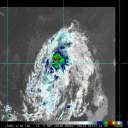Show Selection:
|
#903324 (Received by flhurricane at: 10:44 AM 16.Sep.2017)
TCDAT2
Hurricane Jose Discussion Number 45
NWS National Hurricane Center Miami FL AL122017
1100 AM EDT Sat Sep 16 2017
Earlier microwave data seemed to suggest that Jose`s low-level
center is displaced to the northwest of the mid-level microwave
eye, which is not surprising given that the various shear analyses
indicate about 25 kt from the west-northwest. The initial intensity
is being held at 70 kt, pending the arrival of an Air Force Reserve
Hurricane Hunter aircraft this afternoon.
The shear over Jose is not expected to abate, and in fact, it could
increase further in the next 36 to 48 hours. However, the hurricane
will remain over warm waters south of the Gulf Stream for the next
three days, and the intensity models suggest that it should be able
to at least maintain its intensity, if not strengthen slightly.
After day 3, the hurricane will move north of the Gulf Stream over
much colder water, and that will likely lead to the system weakening
to a tropical storm. Although there will be a cold front
approaching from the northwest by day 5, Jose still looks separated
from the frontal zone at that point, and there is no appreciable
injection of baroclinic energy at that time to allow for
strengthening.
Best I can tell, Jose is moving northwestward with an initial motion
of 320/8 kt. Jose will be moving around the western periphery of a
mid-level high anchored to the east of Bermuda, which will cause it
to turn northward and maintain that heading through day 3. The
track models are tightly clustered during this period, and there is
relatively high confidence in the NHC forecast. After day 3, the
models have come into much better agreement that Jose will become
embedded in the mid-latitude westerlies, and the NHC track forecast
is faster than the previous one by day 5 in order to keep up with
the GFS and ECMWF. Regardless, Jose`s track and an expected
increase in size will likely lead to impacts along the mid-Atlantic
and southern New England coasts in a few days.
KEY MESSAGES:
1. The center of Jose is forecast to pass well east of the North
Carolina coast on Monday, and tropical-storm-force winds are
currently expected to remain offshore of the North Carolina Outer
Banks. However, an increase in the size of the storm or a westward
adjustment in the track forecast could bring tropical storm
conditions closer to the Outer Banks, and interests there should
monitor the progress of Jose through Monday.
2. While Jose is currently forecast to remain offshore of the U.S.
coast from Virginia northward to New England, the large cyclone
could cause some direct impacts to these areas and any deviation to
the left of the NHC forecast track would increase the likelihood and
magnitude of those impacts. Interests along the U.S. east coast
from Virginia to New England should monitor the progress of Jose
through the next several days.
3. Swells generated by Jose are affecting Bermuda, the Bahamas, the
northern coasts of Hispaniola and Puerto Rico, and much of the U.S.
east coast. These swells are likely to cause dangerous surf and rip
current conditions for the next several days in these areas.
FORECAST POSITIONS AND MAX WINDS
INIT 16/1500Z 28.8N 72.2W 70 KT 80 MPH
12H 17/0000Z 29.5N 72.4W 75 KT 85 MPH
24H 17/1200Z 30.8N 72.2W 75 KT 85 MPH
36H 18/0000Z 32.4N 72.0W 75 KT 85 MPH
48H 18/1200Z 34.0N 72.0W 70 KT 80 MPH
72H 19/1200Z 37.2N 71.5W 65 KT 75 MPH
96H 20/1200Z 40.5N 69.5W 60 KT 70 MPH
120H 21/1200Z 41.5N 63.5W 50 KT 60 MPH
$$
Forecaster Berg |



